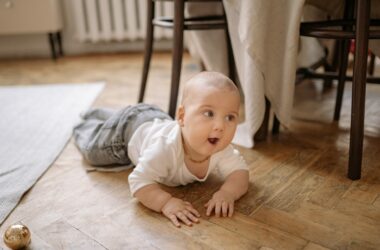When can my pre-toddler or toddler…?
Up to the age of pre-toddler your baby’s physical, mental and emotional development progresses in gradual steps. The interim steps can proceed very quickly, but it sometimes takes a bit longer for the little one to be ready for the new phase.
Milestones that give you a general indication
In broad lines, there are a number of milestones that give you a general indication. We have put them in a list for you.
Ball games
Around their first birthday your little one starts becoming interested in balls. They will probably try to get the apparently indeterminate movements of a ball under control through throwing and kicking. It is only at later stage, between 3 and 4 years that their motor skills are developed enough for them to learn to catch. You can play fun ball games with your toddler. Use a soft ball, roll it to your child and have them throw it back to you. You can gradually increase the distance. Then show your little one that as well as throwing the ball you can kick it. Finally, you can practice catching, starting at a short distance.
Discover and stimulate your baby's mental development
Download nowPushing and pulling
Between the 12th and 18th month your child will discover that toys can be pushed over the floor or can be pulled using a stick or rope. They will love toys that make sounds accompanying the movement, and that stimulate them to develop pushing and pulling. In combination with that, they learn to squat down to reach toys easily, without having to sit. You can show them this movement in a game.
Climbing
Between their first and second birthday your little one will discover that they can climb to reach things that were out of reach before. The downside of this of course is that you really must pay attention to where they go exploring, and you must literally be prepared for any and everything. Kitchen cabinets, chairs, bookshelves, nothing is safe anymore and everything forms a hazard.
- Teach your child to climb safely on a soft surface with cushions. Your child has the need to climb so its best if you can support them in doing so.
- Make sure that bookshelves are securely attached to the wall to prevent them from tipping (you can get attachments for a small price at any DIY store), and make sure any unstable tables are in a safe place.
- Securely store cleaning products and chemicals in a high, locked cupboard. Keep in mind that a kitchen cupboard, a bucket or a laundry basket can be used as a step so that all of a sudden, the crockery and knives on the counter are within easy reach.
Running
Between 18 and 24 months your toddler develops the ability to convert their walking steps into a running motion. It is a thrilling time for them because everything speeds up all of sudden. There is of course the risk of falling, but it is the best way to allow your child to discover the limits of their possibilities. In a safe place, play games with your child that will enable them to gain control of their movements. A running race with children of the same age (or adults!) gets even more exciting if there is a ‘prize’ for the winner on the horizon.
Becoming toilet trained
Many parents long for the time when their toddler will be toilet trained. No more carrying around diapers or trash cans filled with them. The point at which your child becomes toilet trained depends on a number of factors and happens, on average, between the age of 24 and 36 months. But do keep in mind that it can take a bit longer for your child to become completely toilet trained. It is a process of development and your toddler must really be ready for it. You can get an indication of when it is coming by looking out for a few signs; for example, if your toddler tries to take off their diaper or tries to rummage around in it. Also pay attention to the times when they are aware they are weeing and are clamping their legs or even signs like them going into a corner and making a big effort to ‘push’. You can playfully introduce weeing on a potty. Using pull-up diapers that they can take them off themselves can also stimulate the feeling of taking independent action. The most important thing though is patience. Certainly, to start with there will be ‘accidents’ and reprimanding or reacting angrily serves no purpose.
Jumping
Between two and three years old your toddler will discover jumping. Initially it will be a bobbing motion with their two legs on the spot, but the new movement is exciting enough to try and get higher and further each time. Certainly, to start with, this can lead to falls, because at this stage your toddler is learning a new type of coordination – using the head and limbs – and there will always be bump or two as they try it out. Pick a safe place to do jumping games together so that your toddler can master this new technique in a safe and playful way. Take their hands, count to three, and jump. This will help your toddler practice their coordination and get to grips with their movements.
Did this article help you?
Share this article
Receive a notification at the start of a leap!
Would you like to be prepared when your baby is about to enter a leap? Sign up for our leap alarm for free and always receive a notification when a leap is about to start!




